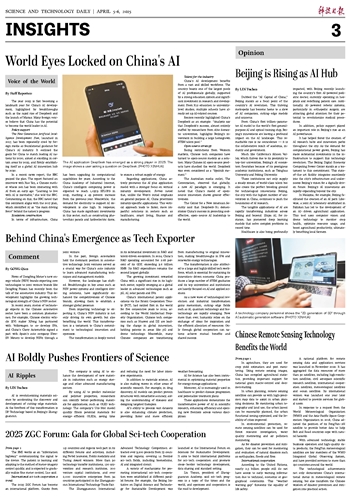
After an earthquake struck Myanmar on March 28, at the request of Myanmar's government, the China National Space Administration's Earth Observation System and Data Center compiled images with data from 17 Chinese satellites. Over 480 suspected disaster sites have been identified across a 120-kilometer radius of the epicenter near Mandalay.
In addition to supporting disaster relief, satellite remote sensing has become a technology that is revolutionizing how we view our globe. Over the last half century, China has witnessed rapid progress in this field.
Rapid development
Back in 1975, China launched its first returnable remote sensing satellite. However, at that time there were no data transmission satellites and remote sensing satellite ground stations. So, China had to purchase satellite data from other countries. Since then, China has made ceaseless efforts to achieve this domestically.
Stepping into the 21st century, several satellite constellations have been formed, being used for land and resources management and monitoring, geographic information mapping, marine dynamic environment monitoring, emergency disaster reduction and environmental protection.
China's remote sensing satellites have made breakthroughs in resolution. Its GaoFen series have reached sub-meter resolution.
The satellite data receiving station network realizes real-time data reception, covering all of China's land and 70 percent of Asia's land area with a high degree of automation.
In the future, remote sensing data sources will be more diverse. The coordinated development of satellites, unmanned aerial vehicles, aerial remote sensing and other platforms will provide us with more comprehensive earth observation data. The integration of AI, machine learning and other technologies with remote sensing will make data processing and analysis more efficient and accurate.
Wide applications
Remote sensing satellites are widely used in the civilian field.
In agriculture, they are used for crop yield estimation and pest monitoring. Using remote sensing images, China has compiled agricultural statistics, providing important support for national grain macro-control and decision-making.
In urban planning, remote sensing satellites can provide us with high-precision map data to assist in urban planning decisions. By monitoring urban topography and land use, the urban layout can be reasonably planned, the urban functional zoning optimized, and the livability of cities improved.
In environmental protection, remote sensing satellites can be used for forest resource investigation, water quality monitoring and air pollution monitoring.
As for disaster prevention and mitigation, they can be used for monitoring and evaluation of natural disasters such as earthquakes, floods and fires.
International cooperation
According to the United Nations, nearly 2.5 billion people still do not have access to early warning information due to technical, economic or geographical constraints. This "weather warning gap" threatens the equality of life safety.
A national platform for remote sensing data and application services was launched in November 2022. It has aggregated the data resources of more than 30 satellites, including high-resolution satellites, civil aerospace scientific research satellites, international cooperation satellites, meteorological satellites and ocean satellites. Its international version was launched one year later and started to provide services for global users.
In response to a request from the World Meteorological Organization (WMO) and the Asia-Pacific Space Cooperation Organization in 2018, China adjusted the position of its FengYun-2H satellite to provide better data to help Belt and Road countries cope with natural hazards.
With advanced technology, stable business operation and high-quality data products, the FengYun meteorological satellites are key members of the WMO Integrated Global Observing System, and have provided services to more than 130 countries around the world.
The technological achievements not only demonstrate China's international status in meteorological remote sensing, but also transform the Chinese wisdom of disaster prevention and mitigation into practical action.


 Next
Next




